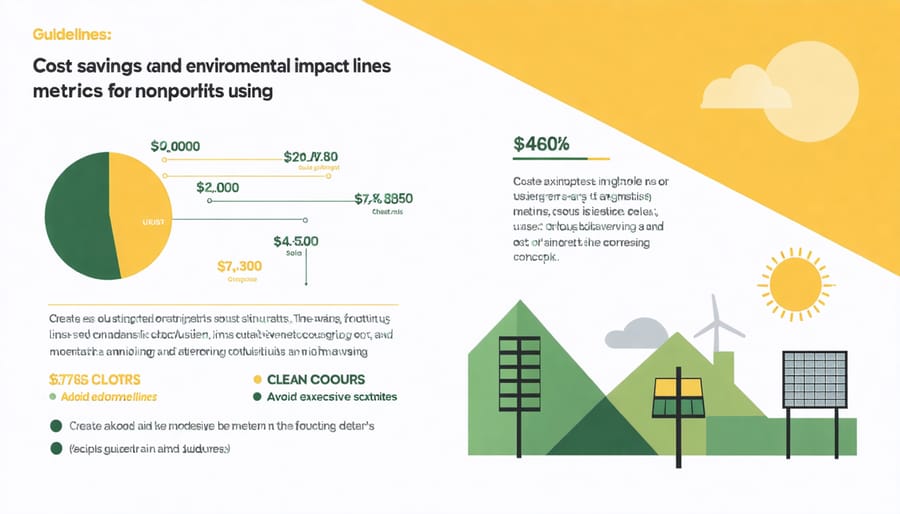Solar energy organizations stand at the forefront of the renewable energy revolution, driving innovation and accessibility in sustainable power solutions across the globe. As climate change concerns intensify and energy costs surge, these organizations play a pivotal role in transforming how businesses and communities access clean, renewable power.
Leading solar energy organizations combine technical expertise with strategic implementation, offering comprehensive solutions that range from initial assessment to long-term maintenance. They serve as crucial bridges between cutting-edge solar technology and practical applications, helping businesses reduce their carbon footprint while achieving significant cost savings.
These organizations typically fall into three distinct categories: nonprofit advocacy groups promoting solar adoption, commercial solar developers implementing large-scale projects, and research institutions advancing solar technology. Each plays a vital role in expanding solar energy’s reach and effectiveness, creating a robust ecosystem that supports sustainable energy transition.
The impact of these organizations extends beyond individual installations – they shape policy, drive technological advancement, and create frameworks for sustainable energy adoption. Through their efforts, solar energy has evolved from an alternative power source to a mainstream energy solution, delivering both environmental and economic benefits to organizations worldwide.
How Solar Energy Organizations Support Nonprofit Success
Customized Financial Solutions
Nonprofit organizations have access to diverse financing options specifically designed to make solar energy adoption more accessible and affordable. Through specialized solar funding for nonprofits, organizations can leverage various financial mechanisms to implement sustainable energy solutions while maximizing their budgets.
Federal and state governments offer substantial grants targeting nonprofit solar installations, often covering up to 30% of project costs through programs like the Solar Investment Tax Credit (ITC). Additionally, many utility companies provide specific incentives and rebates for nonprofit entities, further reducing initial investment requirements.
Power Purchase Agreements (PPAs) have emerged as a popular financing solution, allowing nonprofits to benefit from solar energy with minimal upfront costs. Under these arrangements, third-party investors handle installation and maintenance while organizations pay only for the electricity generated, often at rates lower than conventional utility costs.
Environmental foundations and corporate sustainability programs frequently offer matching grants and low-interest loans specifically for nonprofit solar projects. Community solar initiatives present another viable option, enabling organizations to participate in shared solar arrays when on-site installation isn’t feasible.
Performance-based incentives and renewable energy certificates provide ongoing revenue streams that can help offset operational costs. Many nonprofits also successfully leverage crowdfunding and donor-specific campaigns to finance their solar initiatives, engaging their community while advancing sustainability goals.
Technical Expertise and Implementation
Professional solar installations for nonprofit facilities require careful consideration of multiple technical factors to ensure optimal system performance and longevity. Qualified solar contractors begin with a comprehensive site assessment, evaluating roof structural integrity, available space, sun exposure, and existing electrical infrastructure. This assessment forms the foundation for a customized system design that maximizes energy production while working within facility constraints.
System designers factor in specific organizational needs, including peak usage times, energy consumption patterns, and future expansion plans. They utilize advanced modeling software to calculate optimal panel placement, taking into account factors such as shading, tilt angles, and local weather patterns. This precision in design helps organizations achieve the highest possible return on investment.
Implementation typically involves multiple phases, starting with structural modifications if necessary, followed by mounting system installation, panel placement, and electrical integration. Professional installers ensure compliance with local building codes, electrical standards, and safety regulations throughout the process. They also incorporate monitoring systems that allow organizations to track performance metrics and identify maintenance needs proactively.
Quality assurance measures include thorough testing of all components, proper grounding and surge protection, and detailed documentation of the installation. Many installers also provide staff training on system operation and basic maintenance procedures, ensuring organizations can maximize their solar investment’s benefits long-term.


Key Benefits for Nonprofit Organizations
Cost Reduction and Financial Stability
Solar energy organizations have demonstrated significant success in helping businesses and institutions reduce energy costs while enhancing financial stability. Analysis of implementations across various sectors shows that solar installations typically deliver ROI within 4-6 years, with energy savings extending well beyond 25 years. Organizations can expect to reduce their electricity expenses by 40-75%, depending on system size and local energy rates.
The predictability of solar energy costs provides exceptional budget stability, eliminating exposure to volatile utility pricing. Many organizations report that fixing energy costs through solar adoption has improved their long-term financial planning capabilities. For example, the Melbourne Business Center achieved a 60% reduction in annual energy expenses after installing a 500kW system, with guaranteed pricing for the next two decades.
Financial benefits extend beyond direct savings, including tax incentives, accelerated depreciation, and increased property values. Organizations can also generate additional revenue through feed-in tariffs and renewable energy certificates, creating new income streams while supporting sustainability goals.

Environmental Leadership
Solar energy organizations play a pivotal role in advancing environmental stewardship through strategic initiatives and community engagement. These organizations consistently demonstrate leadership by implementing community solar initiatives that create lasting positive impacts on both local environments and global sustainability goals. Through careful planning and execution, they help reduce carbon emissions while fostering sustainable development practices across diverse communities.
These organizations typically achieve significant environmental milestones through multiple channels: implementing large-scale solar installations, developing educational programs, and creating partnerships with local governments and businesses. Their efforts often result in measurable improvements in air quality, reduced greenhouse gas emissions, and decreased dependency on fossil fuels. Many organizations report annual carbon offset figures equivalent to removing thousands of vehicles from roads or planting millions of trees.
The environmental benefits extend beyond immediate carbon reduction. Solar organizations often incorporate wildlife protection measures in their installation designs, promote sustainable land use practices, and implement water conservation strategies. This comprehensive approach to environmental stewardship creates a blueprint for sustainable development that other industries can follow.
Educational Opportunities
Leading solar energy organizations offer comprehensive educational programs designed to increase public understanding and adoption of solar technology. These initiatives include workshops, webinars, and hands-on training sessions that cater to diverse audiences, from homeowners to building professionals. Organizations frequently partner with educational institutions to develop curriculum materials and certification programs, ensuring a steady pipeline of skilled solar industry professionals.
Community outreach programs focus on demonstrating the practical benefits of solar energy through interactive demonstrations and site visits to successful installations. Many organizations also provide specialized training for facility managers and building operators, covering system maintenance, performance monitoring, and optimization strategies. These educational efforts often include resources for understanding financial incentives, regulatory requirements, and best practices for solar implementation, helping stakeholders make informed decisions about solar energy adoption.
Success Stories: Nonprofits Powered by Solar
Several notable nonprofit organizations have successfully transitioned to solar energy, demonstrating both environmental leadership and financial prudence. The Food Bank of Central New York serves as a compelling example, having installed a 250kW solar array in 2019 that now generates 70% of their facility’s electricity needs. This installation has resulted in annual savings of $45,000, which they redirect to providing an additional 135,000 meals to communities in need.
The Sierra Nevada Field Campus, operated by San Francisco State University, showcases how solar can power remote educational facilities. Their off-grid solar system, completed in 2020, combines 30kW of solar panels with battery storage, enabling them to run their environmental education programs while eliminating diesel generator usage and reducing operating costs by 60%.
Religious institutions have also embraced solar solutions. The First Unitarian Church of Portland implemented a 75kW system that powers their entire facility, including their community outreach center. The project, funded through a combination of grants and congregation donations, achieved complete return on investment within five years and now saves the church $15,000 annually in electricity costs.
Healthcare nonprofits are reporting similar successes. The Valley Community Health Center in Arizona installed a comprehensive solar carport system that provides both shade and power. The 200kW installation reduces their energy expenses by $40,000 yearly, allowing them to expand their medical services to underserved populations.
These implementations demonstrate how solar energy helps nonprofits reduce operational costs while advancing their missions. Common success factors include careful planning, strategic partnerships with solar providers, and creative financing solutions such as power purchase agreements and community fundraising initiatives. The documented outcomes consistently show that initial investments in solar infrastructure generate substantial long-term benefits for nonprofit organizations, their stakeholders, and the communities they serve.
Getting Started with Solar Energy Organizations
Beginning your solar energy journey requires careful planning and strategic partnerships. Start by conducting a comprehensive energy audit to understand your organization’s current consumption patterns and identify potential areas for solar implementation. This initial assessment will help determine the scale of your solar project and establish realistic goals.
Next, research and connect with reputable solar energy organizations that align with your mission. These partnerships can provide valuable insights into the evolution of solar technology and help navigate the complex landscape of renewable energy adoption.
Establish a dedicated team within your organization to oversee the solar initiative. This team should include stakeholders from facilities management, finance, and operations to ensure comprehensive project oversight. They’ll be responsible for developing implementation timelines, managing budgets, and coordinating with solar partners.
Secure funding through various channels, including grants, government incentives, and sustainable energy programs specifically designed for nonprofits. Many organizations offer specialized financing options that can help offset initial installation costs.
Develop a clear communication strategy to inform your stakeholders about the transition to solar energy. This should include regular updates on project milestones, expected benefits, and potential impacts on daily operations. Consider creating educational materials to help staff and beneficiaries understand the importance of this sustainable energy initiative.
Begin with a pilot project to test implementation strategies and gather data on performance and savings. This approach allows for adjustments before expanding to larger-scale installations while demonstrating tangible results to stakeholders.
Solar energy organizations continue to play a pivotal role in shaping our sustainable future while delivering substantial economic benefits. By partnering with these organizations, businesses and institutions can access expertise, resources, and proven implementation strategies that streamline the transition to solar power. The demonstrated success stories across various sectors highlight both the environmental impact and the compelling return on investment that solar initiatives provide. Now is the optimal time to engage with solar energy organizations, leverage available incentives, and position your organization at the forefront of the renewable energy revolution. Take the first step by connecting with reputable solar organizations to explore customized solutions that align with your sustainability goals and financial objectives.

